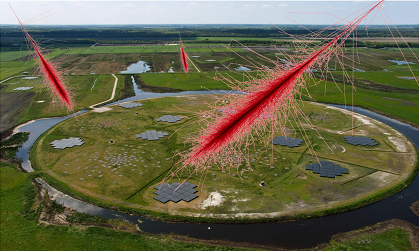Radio squeaks reveal ET particles coming in

LOFAR, the big international radio telescope, can now be used as a particle detector. Astronomers made a model to determine the type and cosmic source of incoming particles. Nature publishes an article about these findings on 3 March.
LOFAR normally receives weak radio waves from the early universe. But now and then an ultra short, bright radio pulse is observed. Your car radio translates this into a little noise – the last signal of an elemental particle entering the atmosphere. Astronomers have now unravelled the radio code of these intruders to determine their type and their cosmic source.
Supernovas, dying stars, black holes. All these have been named as sources of cosmic particles. But until now nobody really knew. Cosmic particles are elementary particles that travel through the universe with an energy that is a million times bigger than the largest particle accelerator on earth. With almost the speed of light, they collide like bullets with the atmosphere, before falling apart into a cascade of other, even smaller particles. Their interaction with the earth's magnetic field leads to a short radio signal, no longer than one billionth of a second. The thousands of LOFAR antennas, placed over a large area that stretches from Ireland to Sweden, Poland, Switzerland and France, help to find the signal and measure it accurately.
Smoking gun
Finding the signal is one thing, knowing what caused it is another. For the first time the astronomers succeeded in calculating and modelling what kind of particle came in. "We can now identify the 'incoming bullet'," Heino Falcke says. Falcke is a professor in Radio Astronomy at Radboud University in the Netherlands and chair of the LOFAR scientific board, who pioneered this new technique. "In most cases this bullet turns out to be a single proton or the light nucleus of a helium atom." This suggests that the source of these particles lies in our Milky Way, which conflicts with the most common theories on the matter.
"Because of the enormous energy, most astrophysicists assume that cosmic particles originate deep in the universe, like black holes in other galaxies," Stijn Buitink says. Professor Buitink from the Vrije Universiteit Brussel is first author of the Nature paper. "But we think they come from a nearby source and get their energy from a cosmic accelerator in the Milky Way – perhaps a very big star..."
Cosmic accelerators
The sources of cosmic particles are cosmic accelerators, a million times stronger than the Large Hadron Collider (LHC) in Geneva or any conceivable man-made accelerator for that matter. "These particles come to earth anyway, so we only have to find them," Falcke says. The new model enabling the astronomers to identify the incoming particles, opens up a new window to the high-energy universe and high-precision measurement of cosmic particles. "We can now do high energy physics with simple FM radio antennas."
Professor Olaf Scholten, Astro Particle Physicist from the University of Groningen, explained that the result is based on very detailed knowledge of all the processes leading to radio emission in the particle cascade that is started by the incoming particle colliding with the atmosphere.
The astronomers are busy bringing the technique to new places, to start with the Pierre Auger Observatory in Argentina. An international cooperation is placing hundreds of radio antennas on the pampas and implementing the LOFAR technique there. "Pierre Auger is the biggest experiment on cosmic particles in the world", says Jörg Hörandel, leader of the Astro Particle Physics group at Radboud University and radio task leader at Auger. "This new method makes it possible to study cosmic particles with an even higher energy and an unprecedented accuracy."
More information: S. Buitink et al. A large light-mass component of cosmic rays at 1017–1017.5 electronvolts from radio observations, Nature (2016). DOI: 10.1038/nature16976
Journal information: Nature
Provided by Radboud University





















